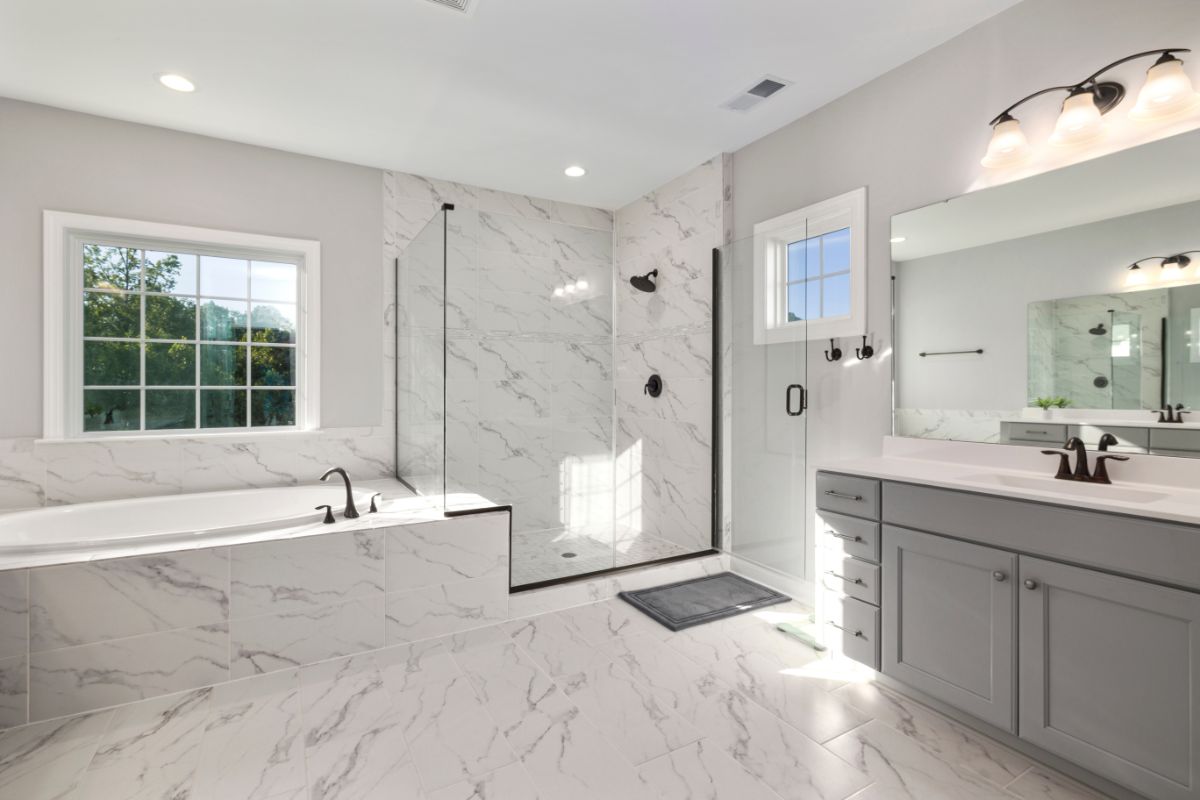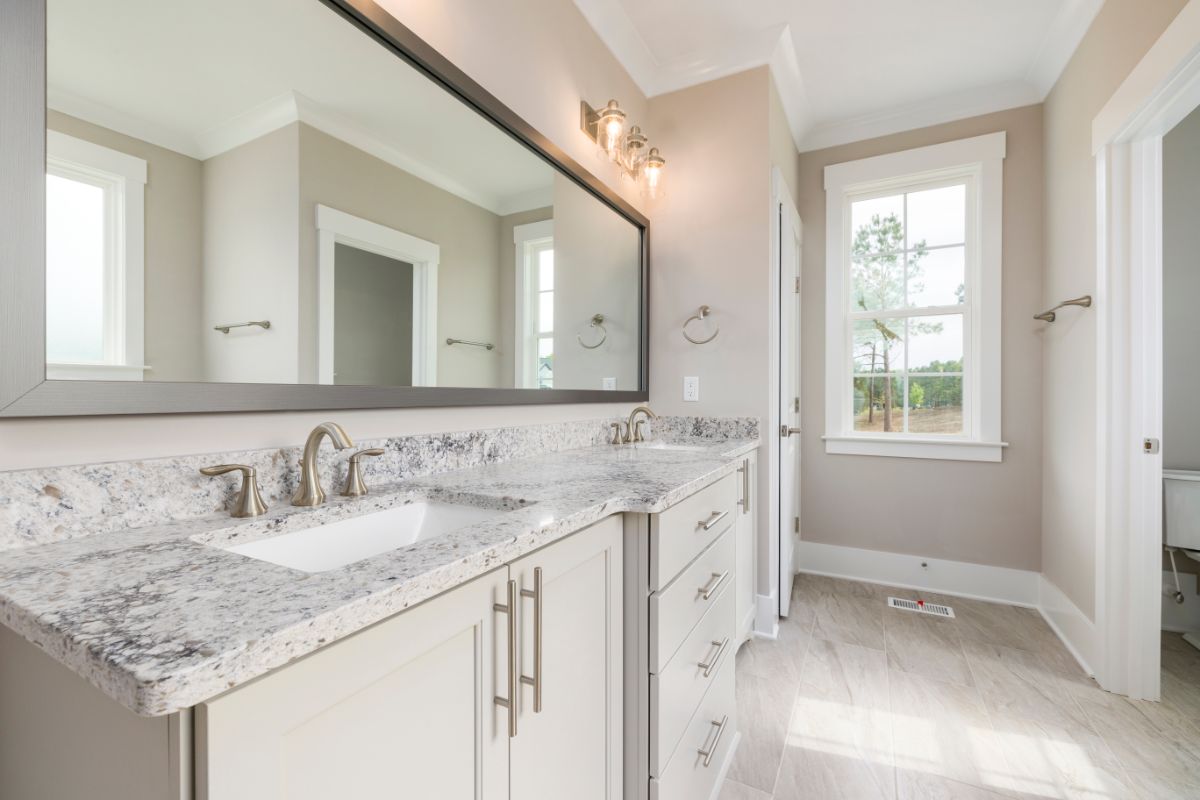If you’re planning on painting or repainting your bathroom, you’ve probably given a lot of thought to the color.
After all, you want your bathroom to look the way you imagined it, and you want the color of the walls to tie in with the rest of the decor and furnishings.

However, when it comes to the paint sheen, you may not even have given this a second thought. After all, how much can it really matter?
The answer is, the paint sheen you choose for your bathroom matters a lot. If you think about it, the bathroom is one of the most high-maintenance rooms in any home.
Bathrooms require regular and thorough cleaning to ensure that they stay as hygienic as possible – after all, you’ll be washing in this room and walking around in bare feet.
Plus, since the bathroom is exposed to high levels of moisture and humidity every day, it’s important to ensure that your surfaces are easy to clean if you want to prevent mold and mildew buildups.
Ease of cleaning is not only important for surfaces such as your sink, toilet, and bathtub, but also for your walls. The last thing you want is to end up with peeling walls after you’ve taken a few showers in your newly painted bathrooms.
In this guide, we’ll be recommending some paint sheen products we think will work in any bathroom, and explaining how to choose the one that will fit your bathroom best.
We’re also going to be sharing some tips for cleaning your bathroom walls without damaging the paintwork, so by the end of this article, you’ll be fully prepared to repaint and enjoy your bathroom.
Different Kinds Of Paint Sheens
The first thing you need to know before you can choose the best paint sheen for your bathroom is that there are many different types of paint sheens out there.
We’ll be recommending the best ones for bathrooms in a moment, but ultimately, you’ll have the freedom to choose any sheen you want, so you should be aware of the whole spectrum of paint sheens before you get started.
Here are the different kinds of paint sheens you’ll find in home improvement stores and through online retailers:
- Matte (flat)
- Eggshell (low shine)
- Satin (moderate shine)
- Semi-gloss (high shine)
- High gloss (extra shiny)
Which Paint Sheen Works Best On Bathroom Walls?
While you technically can use any of the sheens listed above in your bathrooms, some are definitely better than others when it comes to maintaining a clean, mold and mildew-free bathroom.
The top paint sheen we would recommend for your bathroom walls is satin. This is a glossy type of paint, but the finish isn’t so glossy that you’ll be dazzled every time you walk into your bathroom. This level of sheen is ideal for easily cleaning walls.
Semi-gloss is probably the next-best choice for bathrooms, although this sheen is too shiny for many people’s tastes.
You could use an eggshell sheen, but this is the lowest we’d recommend going in terms of sheen. If you choose a flat or matte paint, you’ll probably end up with moisture-related issues over time.
Of course, there is also the option of using high-gloss paint in your bathroom, but most people want to avoid this because the extremely shiny finish can be overly striking for a room than many of us associate with a neutral and peaceful space.
The Best Sheen For Bathroom Ceilings
Since steam rises, the ceiling of your bathroom is likely to be disproportionately affected by moisture.
For this reason, you may want to give extra consideration to the type of paint sheen you use for your bathroom ceiling, and maybe even choose a different sheen from that you have chosen for your walls.
While you can get away with using eggshell sheen on your bathroom walls if you really don’t want glossy walls in this room, you should never use anything less than a satin sheen for the ceiling.
Satin sheen paint is durable and resistant to staining, and it’s glossy enough to make for easy cleaning.
Don’t fall into the trap of spending hours searching for the perfect ‘ceiling paint’. Not all ceiling-friendly paints will be advertised as such, so just look for waterproof paint with a satin sheen at minimum and you will be ready to start painting.
Recommended Bathroom Paint Products
- Prestige Lifetime Satin Paint and Primer
- Country Chic Clear Coat Satin Sheen
- Perma-White Mold and Mildew-Proof Semi-Gloss Interior Paint
- Diamond Brite Paint Kitchen and Bathroom Semi-Gloss Latex Paint
- WaterTite Latex Mold and Mildew Proof Waterproofing Paint
- Boomerang Eco-Friendly Eggshell Interior Paint
- Rust-Oleum Simply Home Eggshell Interior Wall Paint
Best Paint Colors For Your Bathroom

We mentioned earlier that people who are planning to repaint their bathrooms typically focus more on the color than the sheen of their paint, but if you’re still undecided when it comes to the color you want for your bathroom, we have some recommendations.
White is a classic color for a bathroom since it’s neutral and will help to give your bathroom a clean, sparkling appearance – that is, if you are committed to maintenance.
Painting your bathroom all-white can lead to problems down the road if you don’t clean your bathroom often enough since even the slightest bit of grime will show up clearly. Plus, some people think that white makes a bathroom look too sterile and unwelcoming.
If you’d like to stick to neutral colors but want to avoid pure white, you could choose an off-white color like chantilly, cream, peach, or a stone gray.
Alternatively, you could also be bold and go for a more on-trend color for your bathroom. Greens and blues, including darker shades like hunter green or navy blue, are very in right now.
Black accents have also come into fashion in the world of home decor, including bathroom decor, so if you want to make a statement with your bathroom, consider some deep and striking shades.
Bathrooms, Paint, And Mold
Part of the reason we decided to write this guide for you in the first place is because the potential for bathroom mold makes your choice of sheen absolutely crucial if you want to keep your bathroom looking good.
Because of this, we felt we should discuss the issue of bathroom mold in more depth and explain how to prevent and deal with mold on your bathroom walls.
Causes Of Mold On Bathroom Walls
The main cause of mold on bathroom walls is a combination of warmth and moisture known as humidity. Mold loves humid conditions and thrives in areas where the air is hot and moist, so each time you shower or run a bath, you’re essentially inviting mold in!
Mold is especially likely to thrive in bathrooms that aren’t ventilated adequately or where there are leaks, such as from toilets, pipes, or sinks. Moist cellulose materials are also a breeding ground for mold.
Bathroom Mold Prevention Techniques
You can clean mold and mildew off bathroom walls, but it’s even better if you can prevent the growth of these spores in the first place. That way, you won’t have to do arduous and unpleasant cleaning tasks.
To stop mold from taking root in your bathroom walls, you should do your best to keep your bathroom ventilated throughout the year.
It’s easy to fall into the trap of keeping the bathroom window closed in the winter, but this could cause condensation to settle and result in mold growth. If you have a fan or ventilation system built into your bathroom, make sure to use it regularly.
If you spill water in your bathroom, mop it up straight away, even if you have a waterproof floor.
You should also tackle any leaks you find in your bathroom as soon as possible because leaving water to spread across your bathroom floor is a recipe for disaster where mold is concerned. If you can’t fix the leak yourself, call in a professional at the earliest opportunity.
Something many people don’t know is that sunlight is a natural defense against mold, so if you want to stop mold from thriving in your bathroom, you should make sure it gets enough natural light.
Of course, if you don’t have a window in your bathroom, this won’t be possible, and there’s nothing you can do about that. However, if you do have a window, leave it uncovered as much as possible to let the sunlight stream in.
Finally, it’s very important to clean your bathroom regularly. A mistake homeowners often make when it comes to bathroom maintenance is waiting for mold to set in before they set up a serious bathroom cleaning regimen.
However, minimizing dirt (even the low-level, invisible kind) will stop mold from being able to feed and grow, so cleaning your bathroom twice a week is highly recommended.
Cleaning Mold Off Bathroom Walls
If you do end up with some mold on your bathroom walls, don’t panic. This might not be a pleasant sight to see, but you can fix it with the right cleaning techniques.
To start with, protect your health and safety with gloves, goggles, and a respirator rated P-100 or N-95. Ventilate the bathroom as much as possible with an inexpensive box fan (throw this away later to get rid of the spores) and cover up your ducts, air conditioners, and furnaces.
Pure (undiluted) vinegar is a good mold remedy. Just scrub it into the wall if you’re dealing with a small area. For more stubborn mold, combine a quarter-cup white vinegar with two cups of hot water and a couple of tablespoons of borax.
Final Thoughts
Satin sheen is the best paint sheen for bathroom walls and ceilings. You can use anything from eggshell to high gloss sheen for your bathroom walls, but satin is the best. For bathroom ceilings, you should never use a lower sheen than satin.
Using satin sheen for your bathroom walls and ceilings will make these surfaces easier to clean, which helps to prevent mold growth and means you’ll never struggle to keep your bathroom looking and feeling hygienic.
Where possible, choose waterproof paint for your bathroom so it won’t be affected by the moisture in the air.
- How To Drill Into Brick? - October 31, 2022
- How To Repair And Refinish Hardwood? - October 31, 2022
- Floetrol – What Is It? When To Use It: Complete Guide - October 31, 2022
